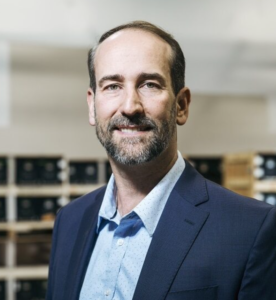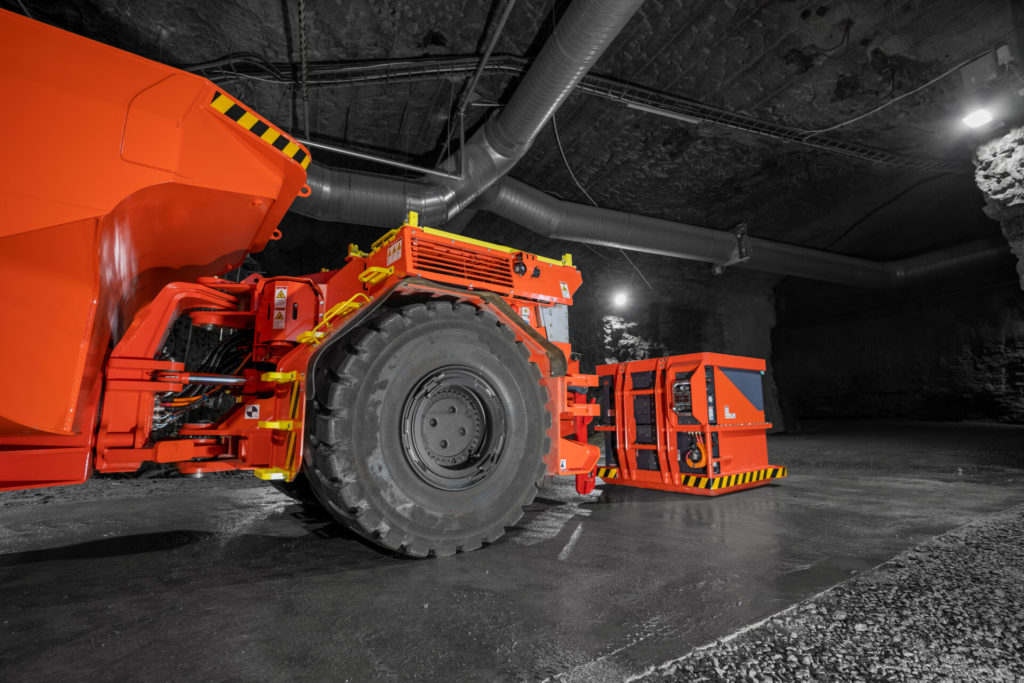Sandvik Mining and Rock Solutions is one of only two Platinum Sponsors of The Electric Mine 2024 event which is running from May 21-23 next week at Crown Perth. Amongst other things its participation includes a large delegation, two speakers, a Sandvik BEV underground customer panel in the conference line-up on Day 1, a Sandvik 65 t class TH665B underground truck in the Outdoor Showcase, plus Sandvik having one of the larger ‘Gigawatt’ booths in the exhibition.
Some mining companies, including juniors, mid-tiers and majors – have already taken the next step and committed to all-electric primary Sandvik fleets for their operations, both established and in-development. Others are starting new pilots and trials with Sandvik BEVs, are part way through them, or in some cases are already operating multiple units. Not only that but there have been major technology steps forward as well – including a higher-capacity battery for Sandvik’s BEV loaders and trucks that delivers 36% more energy in the same envelope. And the global production base is also evolving – beyond its BEV manufacturing locations in Turku, Finland and Camarillo, California, the company recently inaugurated a new production unit in Malaysia at the Sendayan TechValley industrial park which is already producing diesel underground models and will begin producing BEVs in 2025.
Brian Huff, Vice President of New Technology, Load and Haul, Sandvik Mining and Rock Solutions

Plus the long awaited autonomous plus electric question has already been answered with the LH518iB – the AutoMine®-ready version of the 18 t payload LH518B. Moving to drilling, with the DD422iE jumbo, DS412iE bolter and DL422iE production drill, Sandvik has a full range of electric options underground already. The AutoMine Concept Underground Drill, a cabinless BEV drill, shows what is coming in the future. On the surface, it has now produced two full electric concept rigs which are an ideal platform to build on for the future.
Finally – what also makes Perth an ideal hub for the event in 2024 is that Sandvik is playing a central role in the electrification of Australian underground mining and that Australia is the world’s leading underground contract mining market.
Just before Electric Mine 2024 kicks off was a good time to catch up with Brian Huff, Vice President of New Technology, Load and Haul, Sandvik Mining and Rock Solutions on remaining challenges and key issues with electrification underground.
Q The industry seems to now consist of three camps – early adopters going straight into electric fleets, those wanting a halfway house of electric drive/hybrid before going all electric, and those wanting to remain with diesel. Is Sandvik continuing with solutions for all three and why is there diversity in the market?
There will always be different value propositions for different geographical, political and environmental conditions that affect the benefits of electrification. It’s not like suddenly in 2020 the business case for battery-electric went positive for every single mine in the world. Sandvik will continue to offer solutions that fit every need. Our whitepaper released at The Electric Mine 2023 went into those factors in more detail and our conclusion is that about a third of underground mines globally today have a good business case for pure battery-electric. For the rest the business case is still in favour of diesel, diesel-electric or hybrid. Our focus going forward is on creating a platform-based offering that allows different energy sources while leveraging common parts and maintenance procedures to make operating and maintaining the equipment easier.
Q Can you update on the hybrid Sandvik TH66X – is it already undergoing in-mine testing and what are the main areas you want to address in the testing period?
Yes, the concept diesel-electric truck is being tested at the Callio mine in Finland. We are focused on controls system development and verification of performance. So far the results have been better than expected and we’re seeing significant increase in average climbing speed with the same engine powering the truck. A diesel-electric machine is basically a better and faster diesel with environmental benefits, a ‘no brainer’ step towards full zero emissions.
Q Trolley assist is now being looked at at many surface mines – does dynamic charging also have a place underground and what is Sandvik’s take on this?
High-power dynamic charging starts to make sense in applications where large fleets, big machines and long ramps result in very high rate of battery cycling on a BEV fleet (high energy intensity). A trolley assist system can here provide additional power to the machine (higher speed) while reducing the use of the battery. Both are benefits that can help offset the increased capital cost of the trolley infrastructure. The tradeoff in battery maintenance versus ramp and infrastructure maintenance has yet to be determined, but we see the potential of trolley for certain types of mines.
Q Equally is Sandvik still of the belief that a retrofit option to electric for existing equipment is not cost effective or practical?
Sandvik believes the benefits for electrification are more than just decarbonisation. Electrification should also improve productivity and reduce maintenance. Put simply – electric mining equipment is better mining equipment and customers can expect more from it. Conversion of a machine that was originally designed for diesel propulsion doesn’t allow the increase in tractive effort and overall performance that makes such a critical difference in the business case for electrification. Machines have a finite life. It makes more sense to replace end-of-life machines with new ones that are built from the ground up to take advantage of all that electrification has to offer. In industries with long product lifecycles of 10-20, even 30 years, a midlife conversion investment can make a lot of sense as there are still many years left. But heavy mining equipment typically gets replaced every 5-6 years and it simply makes more sense to convert an existing fleet step-by-step as machines reach end of life.
Q Some issues that mines are saying need addressing with all electric equipment are productivity, maintainability and availability. How is Sandvik helping address these areas to ensure parity or better compared to diesel machines?
Parity is not good enough and nothing we strive towards. When introducing new technology, it must perform better than current technology or there will be no acceptance. Over the last decade of experimentation, we’ve seen plenty of proof that electric equipment on its best day is more productive, requires less maintenance and has higher availability than conventional equipment. What needs improvement is the consistency of high performance. This will come from engineering improvements, but perhaps even more so from advances in how the technology is used and maintained. We put a lot of focus these days on what we call ‘operational readiness’ which includes things like production simulations, operator- and maintenance training, charging strategies and parts supply planning. Where an electric fleet is deployed to a mine that is operationally ready, it’s likely to perform above expectations.
Q Electrification will go hand in hand with autonomy. How will AutoMine step up to integrate with your electric fleet and in what ways is this already happening? What level of autonomous operation has been achieved so far with the LH518iB?
Our 18-ton BEV loader Sandvik LH518iB is designed automation-capable as standard and can already be ordered and delivered with the AutoMine onboard kit. Final factory and site testing of the system is ongoing, and we expect to release it for use later this year for both existing and new LH518iB customers.
The Sandvik LH518iB automation capable battery loader

Q What are the biggest obstacles remaining in achieving true autonomous and electric fleets?
Automating the battery-to-charger connection is probably the biggest obstacle remaining to take humans out of the operation. Currently, human involvement is required in charge bays to connect cooling and electrical supply to the batteries, start the charge and then disconnect when charging completes. This operation does bring the opportunity for inspection and some preventative maintenance on a frequent basis but prevents completely autonomous electric fleets. There is no fundamental technical barrier to charging automation, it just hasn’t been developed yet. In the interim automated equipment will drop off and pick up batteries and then people will handle the charging.
Q Have you been able to move beyond single machines to having fleets of electric machines at customer sites? Have you yet achieved an operational and standalone fleet of electric loaders and trucks that is a primary production fleet and not a test fleet?
Certainly yes. We have between 5 and 10 BEV fleet sites running or in delivery phase right now. Most fleet experience to date is with trucks, which is ironic as the loader application is typically easier to electrify. Our best performing BEVs are machines running in fleets and not the single-unit test and experimentation cases, probably for the reasons mentioned earlier around operational readiness and the level of experience and know-how locally at the site.
Q Is the population of electric machines still dominated by LHDs versus trucks due to the different work cycle?
The active fleet is actually currently dominated by BEV trucks rather than loaders, mostly because we were earlier to market with mature BEV truck products. In our order backlog there are more loaders than trucks, but a reasonable balance, no domination of either type of machine. To some extent the benefits are more significant for haulage as that is typically where the most fuel is consumed and the most GHGs are emitted.
Q For static charging do you foresee a situation where you can achieve common battery charging and swapping areas underground that serve load, haul and drilling equipment?
Our drilling solutions do not require chargers as they charge from the grid while drilling and carry their charging systems onboard the machine. Our loading and hauling equipment already utilise a common charging system and can swap in the same swapping bays or in any reasonably flat location. Expanding commonality beyond the Sandvik fleet to enable charging any type of machine from the same charger might sound like a good idea. But in practice there is always a Sandvik battery being charged on a Sandvik charger as operationally it is always optimal to match charging time to the application runtime. So even if you could charge some entirely other type of machine on the charger, it will already be occupied.











